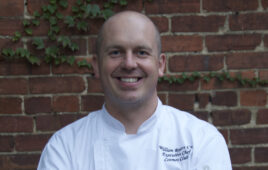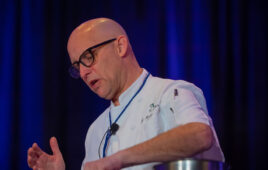 Club chefs are finding clever ways to incorporate molecular gastronomy techniques to add new appeal and distinction to menus and action stations.
Club chefs are finding clever ways to incorporate molecular gastronomy techniques to add new appeal and distinction to menus and action stations.
Molecular gastronomy utilizes the principles of chemistry, physics and biology to develop foods that can be presented in new and interesting ways—spheres made of olive oil, disappearing transparent raviolis, foams, bubbles, and liquid nitrogen. As these techniques become more mainstream, club chefs are finding ways to incorporate them where they make the most sense.
At Trump National Golf Club in Bedminster, N.J., for example, Executive Chef James Haberstroh makes smart use of modernist methods to elevate the club’s ever-changing menus.
One of his favorites applications is liquid nitrogen, which can be used as a coolant in cooking. It’s not an ingredient and so it’s never ingested; it cools the food, then evaporates. At Trump National, Haberstroh uses it as part of a dessert action station, to prepare an ice-cold version of chocolate truffles and cake-batter “fritters” (see photo, above).
“We coat cake batter with Rice Krispie treats, then drop it in liquid nitrogen so that the outside freezes but the inside is gooey,” says Haberstroh. “It’s delicious, the presentation is fun, and the station adds an element of drama.”
The action station is a moneymaker, too, notes Haberstroh. But, he adds, it’s critical for chefs to understand basic safety before trying their own hand at liquid nitrogen.
“I tell my cooks to treat liquid nitrogen like you would hot fryer oil,” he says. “You wouldn’t touch hot fryer oil, so don’t touch liquid nitrogen. And you wouldn’t touch a utensil coming out of fryer oil, so don’t touch one coming out of liquid nitrogen, either.”
Food that has been flash-frozen should also be left to warm up before being touched and eaten, he adds.
Haberstroh relies on other molecular techniques to help him give classic dishes a modern twist. Some favorites include “spherification,” which he uses to transform olive oil into spheres that he then pairs with balsamic vinegar “caviar.” He layers these elements over tomatoes and mozzarella, for a modern take on a caprese salad.
For the club’s wedge salad, he uses tapioca maltodextrin to transform bacon into a powder. On top of the club’s lobster bisque, he gently lays a tarragon foam to add a new taste without changing the physical makeup of the soup.
He also uses agar-agar to create gluten-free gravy for members with dietary restrictions, as well as to set up soy so that it holds better in banquet applications.
“Most of our members don’t always notice or pay attention to the fact that we’re using molecular techniques,” says Haberstroh, who gathered most of his molecular knowledge from a chef-friend who worked with Grant Achatz (the famous chef and restaurateur often identified as one of the leaders in molecular gastronomy). “And we’re okay with that. The point is not to be showy, but to enhance each dish. We use it to add a different texture, enhance the look or elevate the taste. That’s what our members care about.”
At Sawgrass Country Club in Ponte Vedra, Fla., Director of Food & Beverage Perry Kenney and his culinary staff use molecular gastronomy to a lesser degree, but in much the same way as Haberstroh.
“We use liquid nitrogen to create a reverse lava cake,” says Kenney, who was previously Sawgrass’ Executive Chef and was a presenter at C&RB’s 2013 Chef to Chef Conference in Denver. “We do foams and use agar-agar, too.”
Like Haberstroh, Kenney finds that molecular techniques are best used to add value, not as a stand-alone element.
“There are a handful of members looking for these techniques,” he says, noting that they can be effective when used for wine dinners and other special events where members are especially tuned in and food-savvy. “For the others, it’s simply a part of the overall makeup of the dish.”


